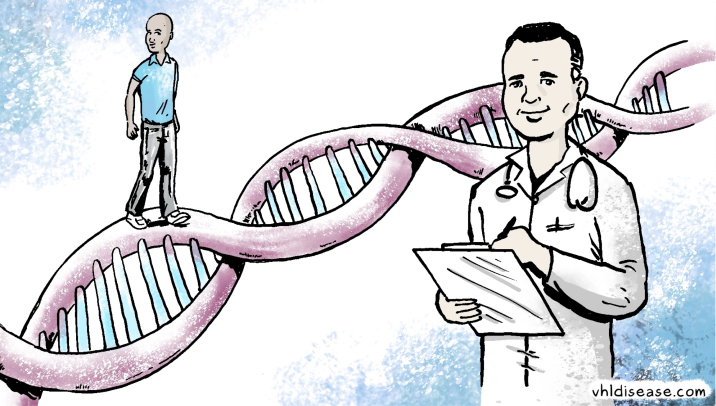This presentation has been created and paid for by Merck. The information in this presentation is intended for health care professionals in the United States and its territories, including Puerto Rico.
Hello, I’m Dr. Wendy Chung, Chief of Clinical Genetics at Columbia University. Today, I’m going to review how to diagnose and identify patients with von Hippel-Lindau, or VHL, disease.
Let’s review the topics we’ll be covering today. We’ll begin with highlighting the variability of VHL disease and challenges associated with diagnosing patients. Then, we’ll review when to consider genetic risk assessment and how to support patients with the disease.
Let’s begin with a brief overview of VHL disease. VHL disease is a rare, systemic, multi-organ, autosomal dominant condition caused by mutations in the tumor suppressor gene, VHL. VHL disease can cause tumors and/or cysts in multiple parts of the body, including the central nervous system, or CNS, kidneys, pancreas, eyes, adrenal glands, and the inner ears.
As previously mentioned, VHL disease is caused by a genetic mutation, and, as such, is largely heritable.
Approximately 80% of people diagnosed with VHL disease have 1 affected parent…
…and about 20% of individuals have de novo mutations with no family history of the disease.
Now, let’s talk about the variability of VHL disease.
Patients with VHL disease display considerable variability in clinical manifestations and genetic mutations, so both should be considered when diagnosing patients.
Clinical manifestations of VHL disease can differ from patient to patient. For example, the rate of new cyst or tumor development can depend on a number of factors, including age, underlying genotypic variant, and the organ or organs involved. Furthermore, tumors can exhibit linear growth, exponential growth, or periods of fluctuation, and saltatory periods and quiescent periods.
Genetic mutations in patients with VHL disease are highly variable, and the spectrum of VHL pathogenic variants is large. In addition, patients can have de novo manifestations without a family history.
So, how are patients with VHL disease diagnosed? While there are no formal guidelines on diagnostic criteria or genetic testing specific to VHL disease, this section gives some guidance on how to diagnose patients with VHL disease.
For all individuals, with or without a family history of the disease, it is suggested that VHL disease should be suspected if any of the following manifestations are present: spinal or cerebellar hemangioblastoma; renal cell carcinoma, or RCC, if the individual is diagnosed at age 46 years or younger, has bilateral or multifocal tumors, or has 1 or more first- or second-degree relatives with RCC; pancreatic neuroendocrine tumors; multiple renal and pancreatic cysts; retinal angioma, especially in a young individual; endolymphatic sac tumors; adrenal or extra-adrenal pheochromocytoma; or less commonly, multiple papillary cystadenomas of the epididymis or broad ligament. These are common manifestations of VHL disease, and this is not an exhaustive list. Patients may present with additional manifestations, and these manifestations will vary from patient to patient.
When VHL disease is suspected in your patient, consider genetic risk assessment, which includes genetic testing and counseling. Molecular genetic testing can identify the germline pathogenic variant in the VHL gene in approximately 95% of patients with a clinical diagnosis of VHL disease. Genetic testing is widely available and accessible to patients and can be ordered by genetic professionals or other genetic providers. Germline genetic testing can: establish the diagnosis for patients suspected of having VHL disease; identify at-risk asymptomatic family members; support periodic follow-up, even if clinical and radiographic features are inconclusive; clarify the need for routine clinical and imaging screening measures; and exclude the VHL diagnosis if test result is negative, unless presenting with a strong family history and/or multiple clinical features. These patients may need to be reevaluated for further genetic testing. During the process of genetic risk assessment, genetic counseling may help patients understand and adapt to the medical, psychological, and familial implications of genetic contributions to their disease. This can include supportive counseling and discussion on the impact of genetic test results on the patient and their families.
Finally, let’s look at how patients with VHL disease can be supported.
Communicating with patients about the role of genetics in VHL disease and assessing their genetic risk may help them understand the disease and encourage early detection. It may also help them to adapt to the multiple implications of the disease. For patients who have at least 1 parent with confirmed VHL disease, consider making genetic testing and subsequent consultation available. When conducting genetic testing, note that specimens may be collected through the patient’s blood, saliva, or epithelial cells. Lastly, genetic professionals can also explain the potential risk of passing disease-causing VHL mutations to offspring. Special precautions and additional surveillance may be required during pregnancy.
Let’s recap what we have just reviewed. VHL disease can display considerable variability; thus, both clinical manifestations and germline genetic testing should be considered to diagnose VHL disease. It is important to communicate the role of genetics in VHL disease with patients, assess the risk of patients, and connect patients to appropriate resources. Thank you for your time today.








